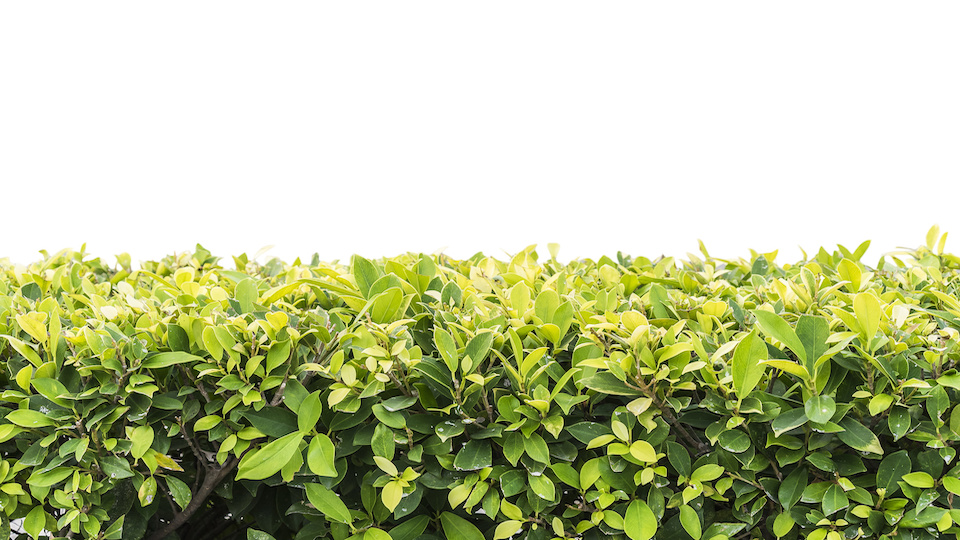It could be argued that a beautiful patio or a well-planned backyard garden deserves to be seen and appreciated, but there are many times that privacy over-rules showcasing your yard. When this is the case, consider replacing traditional privacy such as a fence or brick wall with something more organic. Something that becomes part of the landscape…a living screen.
Living privacy screens add to the aesthetics of your space when viewed from within and from the outside. They offer an element of interest to any landscape with the added bonus of helping to create a beautiful, serene, private outdoor space.
Here are some top ways to create a living privacy screen.
Row plantings
Tall shrubs planted in a row are as effective as a wooden fence, not only in blocking an unwanted view but also minimizing wind and noise as well. Evergreens are ideal as they’re guaranteed to do their duty round the year. Arborvitae, yew, and Leyland cypress are common choices for ease of maintenance, but if you can spare some time and effort on pruning and shaping, you can use shrubs that add more seasonal interest.
For example, holly (female plants) has bright red berries in winter, while firethorns (Pyracantha coccinea) produce white flowers in spring followed by long-lasting orange-red berries. Cotoneasters and heavenly bamboo (Nandina domestica), which is not related to true bamboo, also make good candidates in areas where they remain green through winter.
Plant a double row of corn for a quick, yet practical privacy screen for a pool when it is used only in warmer months. Other edible options are tall varieties of sunflowers or Jerusalem artichokes.
Horsetails grown in large tubs make a simple and effective privacy screen. They are almost zero-maintenance and look very much at home in minimalistic garden layouts.
Multi-trunk trees or shrubs
If you don’t want a hedgerow-like privacy screen or don’t have much space to spare, one or two strategically placed trees or shrubs can provide enough cover.
Chaste tree (Vitex agnus-castus), Crepe myrtle (Lagerstroemia) Fringe Tree or Old Man’s Beard (Chionanthus virginicus), Eastern redbud (Cercis canadensis), Dogwood (Cornus spp.), Japanese maple (Acer palmatum), and Lilac bush (Syringa vulgaris) are all great for providing privacy for a patio or porch.
Train them to be multi-trunk so that the network of branches can act as a screen even when they lose all their leaves.
Climbers on a trellis
The advantage with climbers is that a few plants can cover a large area, while watering and feeding can be limited to the base of the plants. While the plants themselves can be located a few feet away from the porch or patio, you can guide the vines on to trellises flush with the house or on to a freestanding arbor or pergola.
Fast-growing climbers such as morning glories, clematis, and passion fruit vines can be grown on simple trellises to create charming enclosures within a short period.
On the other hand, wisteria, climbing roses, Chinese star jasmine (Trachleospermum jasminoides), and lace cap hydrangeas should be carefully trained on sturdy supports. Although they may take quite some time to establish, your efforts would be rewarded by long-lasting living structures that give years of enjoyment.
Hanging planters
Privacy screens may be created within or along the periphery of the porch with the help of planted pots suspended from hangers.
The list is long when it comes to plants that can be adapted to hanging baskets. Flowering plants include hoyas, petunias, begonias, fuchsias, geraniums, ivy, ferns, creeping Charlie, and succulents like burro’s tail and string of pearls.
Macramé hangers are popular for hanging pots, and you can use a variety of them to hang the plants at different heights.
Tall plants in large planters
A few container plants grouped together or neatly arranged in a row can act as a privacy screen. Their main advantage is flexibility. You can move the containers wherever you need privacy and whenever you need it, for example, when you’re having a small backyard party or during the summer months when the family spends more time on the patio.
Fiddle leaf fig, Ficus, Thuja, Areca palms, tall grasses, and bamboo in containers work very well.
Floating screen of air plants
Air plants or epiphytic bromeliads are a group of plants that don’t need dirt to grow. If you don’t want to bother with potting soil or repotting chores, your best bet is creating a living screen with air plants.
Hang sturdy strings from ceiling hooks and attach individual air plants at different heights using plant clips. Alternatively, the plants may be placed in glass containers with seashells or sea urchin shells attached to the strings at intervals.
Daily misting and a thorough soaking once a week is all that’s required to keep your living screen in good condition.
Here’s to living privacy!
-Susan Patterson




